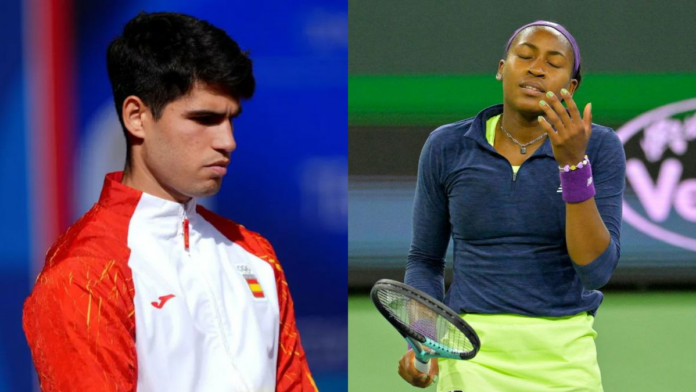Tennis players like Coco Gauff and Carlos Alcaraz often don’t share official clips from their matches. Instead, they repost from official news outlets. But why? Tournament organizers restrict players from sharing match footage to protect exclusive broadcast rights held by major TV networks. This means players might only share a still photo or a short, low-resolution clip much later, if at all, to avoid copyright issues or breaches of their player agreements. It’s a bit bizarre, and Andy Roddick agrees.
Speaking on the Served podcast, Roddick was joined by Jon Wertheim for a lively discussion on Wednesday. Wertheim brought up an interesting point made by Daria Kasatkina, who runs a YouTube vlog called What The Vlog. He said, “She has this vlog, and she basically said, ‘I’m the one out there working, I’m the one sweating. How come I can’t put one clip of me hitting a tennis ball in a match on my own volg?’ tennis is missing the boat here.” Wertheim noted that tennis is missing out by restricting content to official channels.
Roddick added, “Why shouldn’t you be able to post your own clips? What’s the downside to Kasatkina having access to post her own clips? She’ll drive money to the rights holders.” However, the situation is more complex. The question whether tennis players own the content from their own matches doesn’t have a simple answer.
ADVERTISEMENT Article continues below this ad
It’s governed by a mix of legal principles and established practices. But as Jon noted, “Tennis as a collective body should want nothing more than Carlos Alcaraz saying, ‘Hey everyone, did you see the crazy tweener I hit? Here it is.’ If you are a league or tournament, even a rights holder, I want nothing more than Coco and Carlos using their own content to drive engagement with tennis.”
On Instagram alone, Carlos Alcaraz has 6.3 million followers, while Gauff has 1.8 million. These numbers could boost brand engagement and fan dedication, ultimately benefiting the organization. However, copyright law dictates that the ownership of broadcast footage typically belongs to the producer, usually the tournament organizer or broadcaster. They invest heavily in capturing and distributing match broadcasts, and copyright law protects their investment.
In 2024, tennis saw remarkable growth in viewership and social media engagement. Grand Slam events attracted nearly 2 billion viewers across 200+ countries, alongside a 10% rise in on-site attendance, reaching over 3.36 million fans. Social media engagement soared, with the four Grand Slams achieving over 6.3 billion video views and 12 billion impressions—a 30% increase from 2023. Final figures for 2024 are expected to confirm these trends in early 2025.
While they might not own the copyright to match footage, using significant portions without their consent could infringe on these rights. The terms under which players participate in tournaments are often governed by contractual agreements that outline how match footage and player images can be used. Player associations like the PTPA are advocating for greater player control over their commercial rights, including the use of their match performances.
ADVERTISEMENT Article continues below this ad
The PTPA raises the question of players’ rights in terms of publicity
Novak Djokovic’s Professional Tennis Players Association (PTPA) took on tennis’ governing bodies with a bold antitrust lawsuit filed on March 18. Joined by 22 other players, including Nick Kyrgios and Reilly Opelka, the PTPA accuses the ATP, WTA, ITF, and ITIA of monopolizing the sport. The lawsuit claims these organizations exploit players financially and violate their privacy rights.
The PTPA alleges that players are forced to sign over their name, image, and likeness (NIL) rights without compensation. This restriction prevents them from securing independent sponsorships and limits their earning potential. According to the PTPA, these actions reflect an unfair system that exploits players while suppressing competition.
The PTPA claims governing bodies disregard player welfare by enforcing grueling schedules, limiting prize money growth, and offering no compensation for NIL rights. These issues have fueled calls for reform, with players demanding fair treatment akin to athletes in other major sports leagues.
ADVERTISEMENT Article continues below this ad
Djokovic has voiced mixed feelings about the lawsuit but emphasized his commitment to better player representation globally. He stated, “I’ve always fought for better positioning of players in our sport.”
The conclusion of the lawsuit is yet to be disclosed. While some players like Carlos Alcaraz have distanced themselves from the legal action, others are rallying behind the PTPA’s push for change. With ex-pro Andy Roddick and journalist Jon Wertheim also questioning tennis’ structure, the question stands: Will this spark a change in the way tennis is spread? Share your thoughts below!


